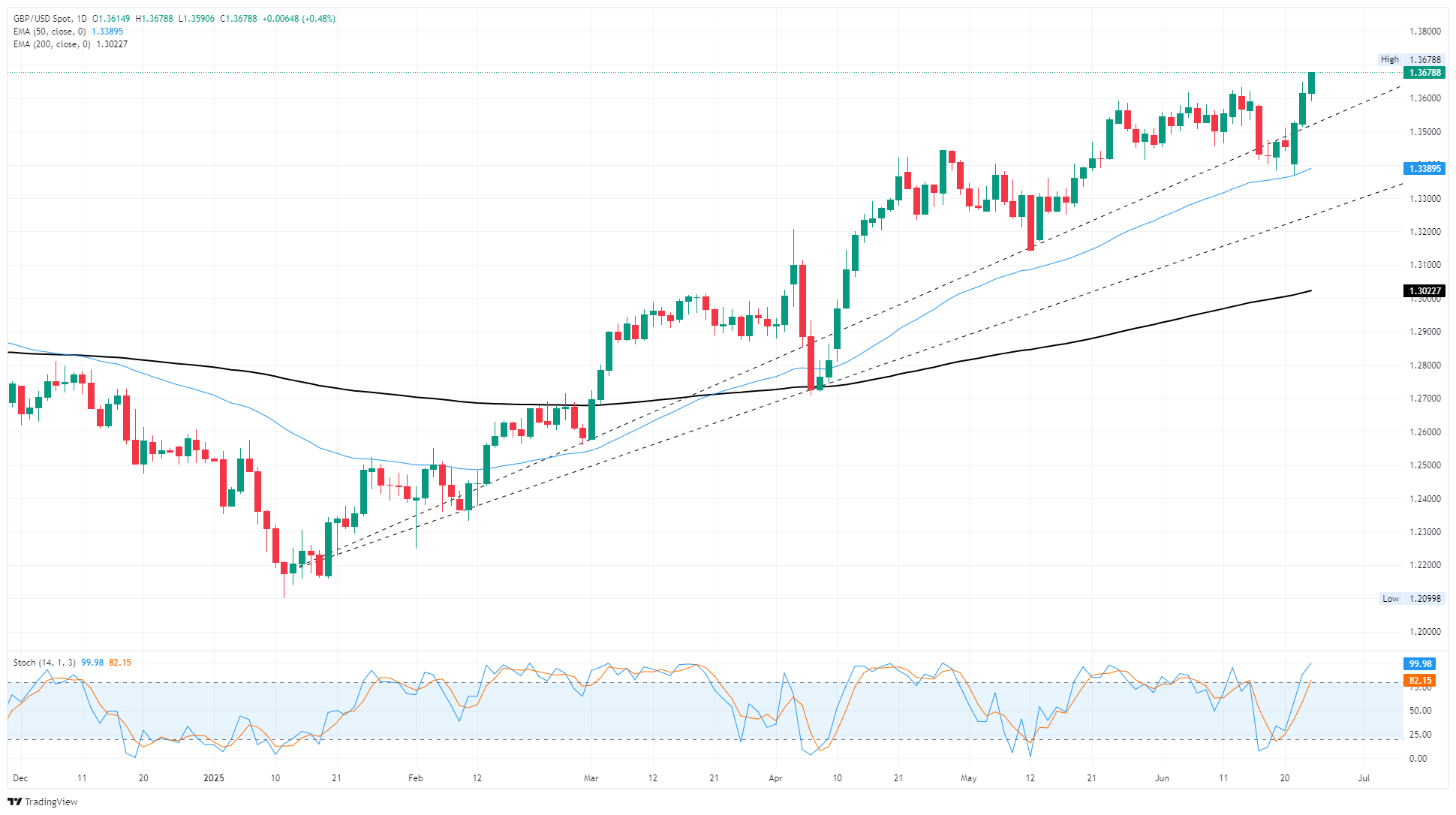GBP/USD extends rally, clips fresh multi-year highs
- GBP/USD climbed its way above 1.3660 for the first time in over 40 months on Wednesday.
- The Pound Sterling is getting a boost from broad-market Greenback selling.
- A smattering of central bank policymaker appearance dot the landscape ahead of GDP updates.
GBP/USD gained more ground as the US Dollar waffles across the board, extending into a third straight day of firm gains and clipping its highest bids in four and a half years. Several central bank policymakers from both the Bank of England (BoE) and the Federal Reserve (Fed) made appearances through the first half of the week, and the trend is expected to continue through the remainder of it.
Fed Chair Jerome Powell wrapped up his two-day stretch of testimony before congressional and Senate financial committees on Wednesday, sticking close to the familiar Fed script and reiterating multiple times the Fed’s wait-and-see stance. The Fed has laid the broad unease about economic conditions at the Trump administration’s feet, and is avoiding making any adjustments to interest rates until the full effects of Donald Trump’s whiplash tariff strategy can be observed.
BoE Governor Andrew Bailey will be taking a turn to address the public on Thursday, where he will be delivering talking points at the British Chambers of Commerce’s annual conference, aptly titled “Where’s the growth?”. UK Gross Domestic Product (GDP) growth figures will follow on Friday, and are expected to show 0.7% QoQ growth through the first quarter.
Before UK growth figures, US Q1 GDP data will be dropping on Thursday. Annualized US GDP is expected to hold steady at -0.2% QoQ as the US economy begins to grapple with its own potential economic slowdown just over the horizon.
GBP/USD price forecast
GBP/USD caught an extended ride into fresh 41-month highs on Wednesday, climbing above 1.3660 for the first time since January of 2022. The pair is on pace to close in the green for a fifth straight month as the US Dollar broadly weakens across the board.
Cable bidders may be flying too close to the sun as GBP/USD price quickly outrun rising trendlines, with price action trading well above the 200-day Exponential Moving Average (EMA) near 1.3020. Technical oscillators are pinned in overbought territory, warning of a potential pullback on the cards.
GBP/USD daily chart

Pound Sterling FAQs
The Pound Sterling (GBP) is the oldest currency in the world (886 AD) and the official currency of the United Kingdom. It is the fourth most traded unit for foreign exchange (FX) in the world, accounting for 12% of all transactions, averaging $630 billion a day, according to 2022 data. Its key trading pairs are GBP/USD, also known as ‘Cable’, which accounts for 11% of FX, GBP/JPY, or the ‘Dragon’ as it is known by traders (3%), and EUR/GBP (2%). The Pound Sterling is issued by the Bank of England (BoE).
The single most important factor influencing the value of the Pound Sterling is monetary policy decided by the Bank of England. The BoE bases its decisions on whether it has achieved its primary goal of “price stability” – a steady inflation rate of around 2%. Its primary tool for achieving this is the adjustment of interest rates. When inflation is too high, the BoE will try to rein it in by raising interest rates, making it more expensive for people and businesses to access credit. This is generally positive for GBP, as higher interest rates make the UK a more attractive place for global investors to park their money. When inflation falls too low it is a sign economic growth is slowing. In this scenario, the BoE will consider lowering interest rates to cheapen credit so businesses will borrow more to invest in growth-generating projects.
Data releases gauge the health of the economy and can impact the value of the Pound Sterling. Indicators such as GDP, Manufacturing and Services PMIs, and employment can all influence the direction of the GBP. A strong economy is good for Sterling. Not only does it attract more foreign investment but it may encourage the BoE to put up interest rates, which will directly strengthen GBP. Otherwise, if economic data is weak, the Pound Sterling is likely to fall.
Another significant data release for the Pound Sterling is the Trade Balance. This indicator measures the difference between what a country earns from its exports and what it spends on imports over a given period. If a country produces highly sought-after exports, its currency will benefit purely from the extra demand created from foreign buyers seeking to purchase these goods. Therefore, a positive net Trade Balance strengthens a currency and vice versa for a negative balance.

